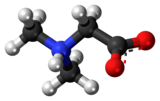
| |

| |
| Names | |
|---|---|
| IUPAC name
N,N-Dimethylglycine
| |
| Systematic IUPAC name
(Dimethylamino)acetic acid | |
| Identifiers | |
3D model (JSmol)
|
|
| 3DMet | |
| 1700261 | |
| ChEBI | |
| ChemSpider | |
| DrugBank | |
| ECHA InfoCard | 100.012.971 |
| EC Number |
|
| 82215 | |
| KEGG | |
| MeSH | dimethylglycine |
PubChem CID
|
|
| RTECS number |
|
| UNII | |
CompTox Dashboard (EPA)
|
|
| |
| |
| Properties | |
| C4H9NO2 | |
| Molar mass | 103.121 g·mol−1 |
| Appearance | White crystals |
| Odor | Odourless |
| Density | 1.069 g/mL |
| Melting point | 178 to 182 °C (352 to 360 °F; 451 to 455 K) |
| Boiling point | 175.2 °C (347.4 °F; 448.3 K) |
| Hazards | |
| GHS labelling: | |

| |
| Warning | |
| H302 | |
| Lethal dose or concentration (LD, LC): | |
LD50 (median dose)
|
>650 mg kg−1 (oral, rat) |
| Related compounds | |
Related alkanoic acids
|
|
Related compounds
|
Dimethylacetamide |
Except where otherwise noted, data are given for materials in their standard state (at 25 °C [77 °F], 100 kPa).
| |
Dimethylglycine (DMG) is a derivative of the amino acid glycine with the structural formula (CH3)2NCH2COOH. It can be found in beans and liver, and has a sweet taste. It can be formed from trimethylglycine upon the loss of one of its methyl groups. It is also a byproduct of the metabolism of choline.
When DMG was first discovered, it was referred to as Vitamin B16, but, unlike true B vitamins, deficiency of DMG in the diet does not lead to any ill-effects and it is synthesized by the human body in the citric acid cycle meaning it does not meet the definition of a vitamin.